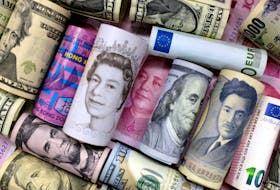By Gertrude Chavez-Dreyfuss
NEW YORK (Reuters) - The dollar dropped to two-week lows on Wednesday, showing reduced safe-haven appeal for now, as U.S. tech stocks rallied and commodity prices firmed, even as sentiment remained cautious amid a resurgence of new coronavirus cases globally, particularly in the United States.
The euro, meanwhile, rose to three-week highs against the dollar, while commodity currencies such as the Australian, New Zealand, and Canadian dollars gained.
The NASDAQ index <.IXIC> hit a record closing high, supported by technology shares, reversing Tuesday's loss, feeding the currency market's risk appetite.
The dollar is typically seen as a safe haven for investors to park their cash each time a resurgence of the pandemic seems to threaten a global economic recovery.
"Investors are growing more confident that this stock market rally is not going to end any time soon," said Edward Moya, senior market analyst, at OANDA in New York. "And that's pretty much based on expectations that you're going to continue to see a strong global stimulus response over the coming weeks and months."
That said, the U.S. Centers for Disease Control and Prevention (CDC) on Wednesday reported 2,982,900 cases of new coronavirus, an increase of 50,304 cases from its previous count. It said the number of deaths had risen by 932 to 131,065.
Against a basket of its rivals, the dollar <=USD> dropped 0.5% to 96.479 in late afternoon trading.
A decline in the dollar earlier this week set off the so-called "Death Cross," a bearish technical formation that occurs when the 50-day moving average crosses below the 200-day moving average.
Past occurrences of the Death Cross have been followed by dollar weakness eight out of nine times since 1980 when the 200-day moving average has been declining, as it is now, analysts at BofA Securities said.
The euro
Commodity currencies, which tend to thrive in times of increased risk appetite, also gained against the dollar.
The Australian dollar rose 0.5% against the greenback to US$0.6981
Against the safe-haven yen, the dollar was down 0.2% on the day at 107.24 yen
Sterling
(Reporting by Gertrude Chavez-Dreyfuss; Editing by Jonathan Oatis and Nick Zieminski)









